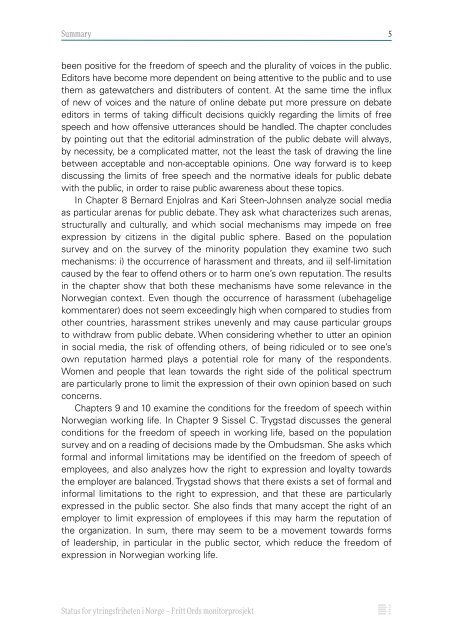Ytringsfrihet_Hovedrapport_DIG
Ytringsfrihet_Hovedrapport_DIG
Ytringsfrihet_Hovedrapport_DIG
Create successful ePaper yourself
Turn your PDF publications into a flip-book with our unique Google optimized e-Paper software.
Summary<br />
5<br />
been positive for the freedom of speech and the plurality of voices in the public.<br />
Editors have become more dependent on being attentive to the public and to use<br />
them as gatewatchers and distributers of content. At the same time the influx<br />
of new of voices and the nature of online debate put more pressure on debate<br />
editors in terms of taking difficult decisions quickly regarding the limits of free<br />
speech and how offensive utterances should be handled. The chapter concludes<br />
by pointing out that the editorial adminstration of the public debate will always,<br />
by necessity, be a complicated matter, not the least the task of drawing the line<br />
between acceptable and non-acceptable opinions. One way forward is to keep<br />
discussing the limits of free speech and the normative ideals for public debate<br />
with the public, in order to raise public awareness about these topics.<br />
In Chapter 8 Bernard Enjolras and Kari Steen-Johnsen analyze social media<br />
as particular arenas for public debate. They ask what characterizes such arenas,<br />
structurally and culturally, and which social mechanisms may impede on free<br />
expression by citizens in the digital public sphere. Based on the population<br />
survey and on the survey of the minority population they examine two such<br />
mechanisms: i) the occurrence of harassment and threats, and ii) self-limitation<br />
caused by the fear to offend others or to harm one’s own reputation. The results<br />
in the chapter show that both these mechanisms have some relevance in the<br />
Norwegian context. Even though the occurrence of harassment (ubehagelige<br />
kommentarer) does not seem exceedingly high when compared to studies from<br />
other countries, harassment strikes unevenly and may cause particular groups<br />
to withdraw from public debate. When considering whether to utter an opinion<br />
in social media, the risk of offending others, of being ridiculed or to see one’s<br />
own reputation harmed plays a potential role for many of the respondents.<br />
Women and people that lean towards the right side of the political spectrum<br />
are particularly prone to limit the expression of their own opinion based on such<br />
concerns.<br />
Chapters 9 and 10 examine the conditions for the freedom of speech within<br />
Norwegian working life. In Chapter 9 Sissel C. Trygstad discusses the general<br />
conditions for the freedom of speech in working life, based on the population<br />
survey and on a reading of decisions made by the Ombudsman. She asks which<br />
formal and informal limitations may be identified on the freedom of speech of<br />
employees, and also analyzes how the right to expression and loyalty towards<br />
the employer are balanced. Trygstad shows that there exists a set of formal and<br />
informal limitations to the right to expression, and that these are particularly<br />
expressed in the public sector. She also finds that many accept the right of an<br />
employer to limit expression of employees if this may harm the reputation of<br />
the organization. In sum, there may seem to be a movement towards forms<br />
of leadership, in particular in the public sector, which reduce the freedom of<br />
expression in Norwegian working life.<br />
Status for ytringsfriheten i Norge – Fritt Ords monitorprosjekt


